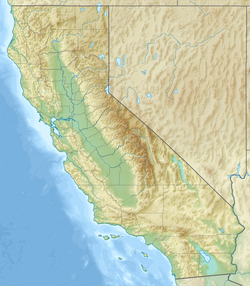The 1990 Upland earthquake occurred at 15:43:37 local time on February 28 with a moment magnitude of 5.7 and a maximum Mercalli Intensity of VII (Very strong). This left-lateral strike-slip earthquake occurred west of the San Andreas Fault System and injured thirty people, with total losses of $12.7 million. Many strong motion instruments captured the event, with an unexpectedly high value seen on water tank near the epicentral area.
| UTC time | 1990-02-28 23:43:36 |
|---|---|
| ISC event | 380064 |
| USGS-ANSS | ComCat |
| Local date | February 28, 1990 |
| Local time | 23:43:37 UTC[1] |
| Magnitude | 5.7 Mw[1] |
| Depth | 10 km (6.2 mi)[1] |
| Epicenter | 34°10′N 117°44′W / 34.16°N 117.73°W[1] |
| Fault | San Jose Fault |
| Type | Strike-slip[2] |
| Areas affected | Greater Los Angeles Area Southern California United States |
| Total damage | $12.7 million[2] |
| Max. intensity | MMI VII (Very strong)[3] |
| Peak acceleration | 1.05 g[4] |
| Casualties | 30 injured[2] |
Tectonic setting
editIn the Transverse Ranges west of the right-lateral San Andreas Fault System, some faults exhibit left-lateral slip, including some at the boundary of the Los Angeles Basin and the Transverse Ranges.[5]
Earthquake
editWhile several examinations of earthquake focal mechanisms in the Upland area showed both thrust and strike-slip faulting on opposite ends of the San Jose Fault, the mechanism of the 1990 event showed pure left-lateral motion on a steeply-dipping (70°) and northeast-striking fault. Field investigations revealed that the bilateral rupture did not reach the surface.[6]
Strong motion
editThe shock was felt from Santa Barbara in the west and to Las Vegas in the east. It was also felt in Ensenada, Baja California and it triggered 82 strong motion instruments at distances of 3–76 kilometers (1.9–47.2 mi). Typical ground accelerations were around 0.1 g at distances of up to 30 km (19 mi), but some closer stations had significantly higher responses.[4]
Damage
editRockslides left some roads closed in the San Gabriel Mountains and Pomona city hall was heavily damaged. In Claremont some buildings were damaged, but only one building in Upland's historic downtown area was tagged for non-occupation. Those that were injured suffered cuts and bruises (mainly from falling objects) but two men were injured as a result of a landslide.[7][8]
See also
editReferences
edit- ^ a b c d ISC (2016), ISC-GEM Global Instrumental Earthquake Catalogue (1900–2012), Version 3.0, International Seismological Centre
- ^ a b c PAGER-CAT Earthquake Catalog, Version 2008_06.1, United States Geological Survey, September 4, 2009
- ^ National Geophysical Data Center / World Data Service (NGDC/WDS) (1972), Significant Earthquake Database (Data Set), National Geophysical Data Center, NOAA, doi:10.7289/V5TD9V7K
- ^ a b Etheredge, E. C.; Acosta, A. V.; Foote, L. J.; Johnson, D. A.; Maley, R. P.; Porcella, R. L.; Switzer, J. C. (1990), Strong-motion recordings from the ML=5.5 Upland, California earthquake of February 28, 1990, Open-File Report 90-311, United States Geological Survey, pp. 1–5
- ^ Yeats, R. (2012), Active Faults of the World, Cambridge University Press, pp. 107–110, ISBN 978-0521190855
- ^ Hauksson, E.; Jones, L. (1991), "The 1988 and 1990 Upland Earthquakes: Left-Lateral Faulting Adjacent to the Central Transverse Range" (PDF), Journal of Geophysical Research, 96 (B5): 8144, 8151, Bibcode:1991JGR....96.8143H, doi:10.1029/91jb00481
- ^ Warren, J.; Roderick, K. (March 1, 1990). "Quake Damage at Least $20 Million : New Slide Recloses Mt. Baldy Road; Aftershocks Continue". Los Angeles Times.
- ^ Malnic, E.; Sahagun, L. (March 1, 1990). "Quake Hits Vast Area of Southland : Seismic: Epicenter near Upland. Some damage but only minor injuries reported. Estimated strength of temblor varies from 5.5 to 6.1". Los Angeles Times.
External links
edit- M5.5 – 6km NNE of Claremont, CA – United States Geological Survey
- The International Seismological Centre has a bibliography and/or authoritative data for this event.
